How to calculate
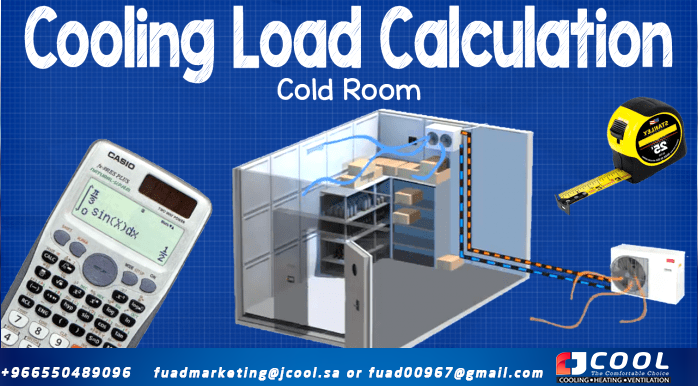 |
| Cooling Load Calculation |
alculation of refrigerated load for refrigerated rooms. In this article we will see how to calculate the refrigeration load of a cold room. First we will see the heat sources, then we will see a practical example of calculating the cooling load of a cold room in a simplified example.
Scroll down to see the video tutorial.
Do you want free cold room calculation design software?
Download Coolselector®2 for free -> Click here
With Danfoss you can build durable and efficient cold rooms. Its broad range of products and market-leading application expertise enable it to anticipate and comply with future refrigeration and power regulations. Go green and stay ahead of the competition without
performance commitment.
More information about solutions for cold rooms here
What is a cold room?
A cold room is used to store perishable items like meat and vegetables to slow their spoilage and keep them as fresh as possible for as long as possible. The heat accelerates its deterioration, so the products are cooled, eliminating the heat.
To evacuate the heat we use a refrigeration system that allows precise and automatic control of the temperature to preserve the merchandise for as long as possible.
 |
| Refrigeration system – Cold room |
To remove the heat, we need to know what the cooling load will be. The cooling load varies throughout the day, so in most cases the average cooling load is calculated and the cooling capacity is calculated accordingly.
Heat sources for cold rooms
Where does all the heat that we have to evacuate come from?
 |
| transmission load |
Typically 5-15% comes from transmission charges. This is the heat energy transferred through the ceiling, walls and floor into the cold room. Heat is always flowing from hot to cold and the inside of the cold room is obviously much colder than its surroundings, so heat is always trying to get into the space due to this temperature difference. If the cold room is exposed to direct sunlight, the heat transfer will be higher and therefore additional correction will need to be applied to account for this.
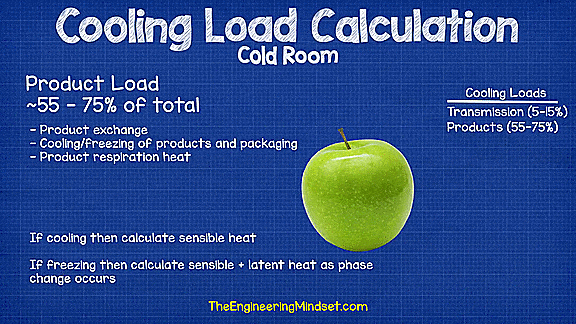 |
| product loading |
Then we have product loads that are typically 55-75% of the refrigeration load. This explains the heat that is introduced into the cold room when new products enter. It is also the energy needed to cool, freeze, and further cool after freezing. If you are only cooling products, you only need to consider the sensible heat load. If you freeze the product, you also need to consider the latent heat when a phase change occurs. During this time energy is being used but you will not see a change in temperature as the product transitions from a liquid state to a frozen state. Additional energy is needed to further cool these foods below freezing, which again is sensible heat. You should also consider the packaging, as this will also be cold by nature. Finally, if you are cooling fruits and vegetables, these products are alive and generate heat, so you will have to take this into account as well.
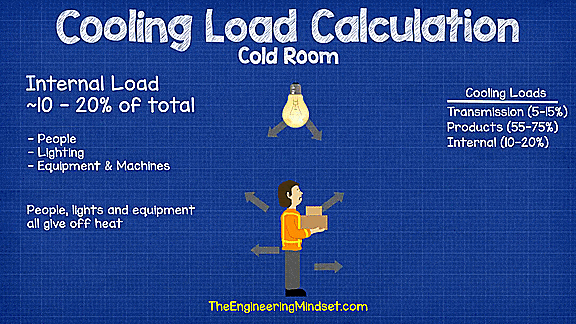 |
| internal charge |
The next thing to consider are the internal loads that are around 10-20%. These are the heat given off by people working in the cold room, lighting, and equipment such as forklifts, etc. To do this, you'll need to consider what equipment staff will use to move products in and out of the store, how much heat they and equipment emit, and the daily duration.
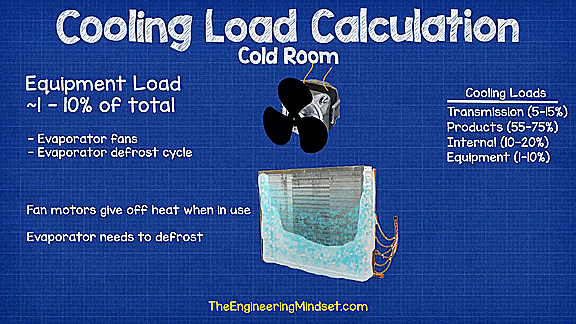 |
| equipment load |
Next, we need to consider the cooling equipment in the room, which will account for approximately 1-10% of the total cooling load. For this we want to know the power of the fan motors and estimate how long they will run each day, then we also want to take into account the heat transferred to the space from the evaporator defrost.
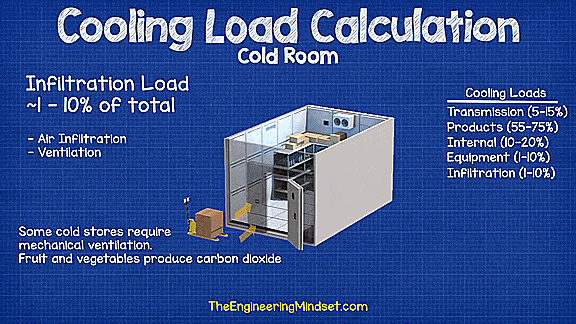 |
| Infiltration heat load |
The last thing we need to consider is infiltration which again adds 1-10% to the cooldown load. This happens when the door is opened, so there is heat transfer to the space through the air. The other consideration is ventilation. Fruits and vegetables give off carbon dioxide so some shops will need a fan, this air needs to be cooled so keep this in mind if using.
Calculation of the refrigeration load – Example of working in a cold room
Consider a simplified example of a cooling load calculation for a cold room. Now, if you're doing this as a real-life example, I recommend using design software like the Danfoss Coolselector app for speed and accuracy. Download here -> http://bit.ly/2Ars6yF
transmission load
· The dimensions of our cold room are 6m long, 5m wide and 4m high.
· Ambient air is 30°C at 50% RH, indoor air is 1°C at 95% RH
· The walls, ceiling and floor are insulated with 80 mm polyurethane with a U value of 0.28 W/m2.K
· The ground temperature is 10°C.
Just keep in mind that the manufacturer has to tell you what the u-value is for the insulation boards, otherwise you'll have to calculate it.
To calculate the transmission load, we will use the formula
Q = U x A x (Outlet temperature – Inlet temp.) x 24 ÷ 1000.
· Q= heat load kWh/day
· U = U value of the insulation (we already know this value) (W/m2.K)
· A = area of ceiling and floor walls (we will calculate this) (m2)
· Temp in = The air temperature inside the room (°C)
· Temp out = Outside air ambient temperature (°C)
· 24 = Hours in a day
· 1000 = conversion from Watts to kW.
Calculating "A" is pretty easy, it's just the size of each interior wall, so drop the numbers in to find the area of each wall, ceiling, and floor.
Side 1 = 6m x 4m = 24m2
Side 2 = 6m x 4m = 24m2
Side 3 = 5m x 4m = 20m2
Side 4 = 5m x 4m = 20m2
Roof = 5m x 6m = 30m2
Floor = 5m x 6m = 30m2
We can then run those numbers into the formula we saw above, you'll need to calculate the floor separately from the walls and ceiling, since the temperature difference is different under the floor, so the heat transfer will be different.
walls and ceiling
Q = U x A x (Output temp. – Inlet temp.) x 24 ÷ 1000
Q = 0.28W/m2.K x 113m2 x (30°C – 1°C) x 24 ÷ 1000
Q = 22 kWh/day
[113m2 = 24m2 + 24m2 + 20m2 + 20m2 + 30m2 + 30m2]
I usually
Q = U x A x (Output temp. – Inlet temp.) x 24 ÷ 1000
Q = 0.28W/m2.K x 30m2 x (10°C – 1°C) x 24 ÷ 1000
Q = 1.8 kWh/day
If the floor is not insulated, you will need to use a different formula based on empirical data.
Total daily transmission heat gain = 22 kWh/day + 1.8 kWh/day = 23.8 kWh/day
Remember that if your cold room is exposed to direct sunlight, you will also need to consider solar power.
Product Upload – Product Exchange
Next, we will calculate the refrigeration load from the exchange of products, that is, the heat that the new products that are at a higher temperature contribute to the cold room.
For this example, we are going to store apples, we can look up the specific heat capacity of the apples, but remember that if you are freezing produce, it will have a different specific heat when chilled, frozen, and subcooled. This needs to be taken into account and calculated separately, but in this example we are just cooling.
Every day 4000 kg of new apples arrive at a temperature of 5°C and a specific heat capacity of 3.65 kJ/kg.°C.
So we can use the formula
Q = m x Cp x (temperature input – temperature storage) / 3600.
· Q = kWh/day
· CP = Specific heat capacity of the product (kJ/kg.°C)
· m = the mass of new products each day (kg)
· Temp enter = the inlet temperature of the products (°C)
· Store temp = the temperature inside the store (°C)
· 3600 = convert from kJ to kWh.
Calculation
Q = m x Cp x (Inlet temperature – Storage temp.) / 3600
Q = 4000 kg x 3.65 kJ/kg.°C x (5°C – 1°C) / 3600.
Q = 16kWh/day
Product loading: product respiration
Next, we calculate the respiration of the product, it is the heat generated by living products such as fruits and vegetables. These will generate heat because they are still alive, so we cool them to stop their deterioration and keep them longer.
For this example, I used 1.9 kJ/kg per day on average, but this rate changes with time and temperature. In this example, we use an empirical value only to simplify the calculation, since this cooling load is not considered critical. If you were to calculate a critical load, you should use a higher precision. In this example, the store maintains a stock of 20,000 kg of apples.
To calculate it we will use the formula
Q = m x resp / 3600
- Q = kWh/day
- m = mass of stored product (kg)
- resp = the respiratory heat of the product (1.9kJ/kg)
- 3600 = convert kJ to kWh.
Q = m x resp / 3600
Q = 20,000 kg x 1.9 kJ/kg / 3,600
Q = 10.5 kWh/day
For the produce section, we'll add the product exchange of 16 kWh/day and the respiration load of 10.5 kWh/day for a total product load of 26.5 kWh/day.
Internal heat load - People
Then we will calculate the internal loads of the people who work in the cold room, because people generate heat and we have to take that into account.
We will estimate that 2 people work in the shop for 4 hours a day and we can look up and see that at this temperature they will be putting out about 270 watt hours of heat inside.
We will use the formula:
Q = persons x time x heat / 1000
- Q = kWh/day
- people = how many people inside
- time = time spent indoors each day per person (Hours)
- heat = heat loss per person per hour (watts)
- 1000 just converts watts to kW
Calculation:
Q = people x time x heat / 1000
Q = 2 x 4 hours x 270 Watts / 1000
Q = 2.16 kWh/day
Internal thermal load: lighting
So we can calculate the heat released by lighting, it's quite simple to do and we can use the formula
Q= lamps x time x power / 1000
- Q = kWh/day,
- lamps = number of lamps in the cold room
- time = hours of use per day
- wattage = rated power of the lamps
- 1000 = converts watts to kW.
If we have 3 lamps of 100 W each, working 4 hours a day, the calculation would be:
Q= lamps x time x power / 1000
Q= 3 x 4 hours x 100W / 1000
Q= 1.2kWh/day
For the total internal load, we simply add the people load (2.16 kWh/day) and the lighting load (1.2 kWh/day) to get a value of 3.36 kWh/day.
Equipment Load - Fan Motors
Now we can calculate the heat generation of the fan motors in the evaporator. To do this, we can use the formula:
Q = fans x time x power / 1000
- Q = kWh/day
- fans = the number of fans
- time = hours of daily operation of the fan (hours)
- power = the rated power of the fan motors (watts)
- 1000 = conversion from watts to kW.
In this cold room evaporator we will use 3 fans of 200W each and we estimate that they will work 14 hours a day.
Calculation:
Q = fans x time x power / 1000
Q = 3 x 14 hours x 200W/1000
Q = 8.4kWh/day
Equipment Load - Fan Motors
Now we will calculate the thermal load caused by the defrost of the evaporator. To calculate it we will use the formula:
Q = power x time x cycles x efficiency
- Q = kWh/day,
- power = nominal power of the heating element (kW)
- time = defrost time (hours)
- cycles = how many times a day the defrost cycle will occur
- efficiency = what % of the heat will be transferred to the space.
In this example, our cold room uses a 1.2 kW electric heater, runs for 30 minutes 3 times a day, and it is estimated that 30% of all the energy it consumes is simply transferred to the cold room.
Q = power x time x cycles x efficiency
Q = 1.2 kW x 0.5 hour x 3 x 0.3
Q = 0.54kWh/day
The total equipment load is then the fan heat load (8.4 kWh/day) plus the defrost heat load (0.54 kWh/day), which equals 8.94 kWh/day.
Filtration charge
Now we need to calculate the heat load due to air infiltration. I'll use a simplified equation, but depending on the importance of your calculation, you may need to use other, more complete formulas to achieve greater accuracy. We will use the formula:
Q = changes x volume x energy x (outlet temp – inlet temp) / 3600
- Q = kWh/day
- changes = number of volume changes per day
- volume = the volume of the cold room
- energy = energy per cubic meter per degree Celsius
- Temp out is the outside air temperature
- Temp in is the temperature of the air inside
- 3600 is just for converting from kJ to kWh.
It is estimated that there will be 5 volumes of air renewal per day due to the opening of the door, the volume is calculated at 120m3, each cubic meter of fresh air contributes 2kJ/°C, the outside air is at 30°C and the air inside is 1°C
Q = changes x volume x energy x (outlet temp – inlet temp) / 3600
Q = 5 x 120m3 x 2kJ/°C x (30°C – 1°C ) / 3600
Q = 9.67 kWh/day
total refrigeration load
To calculate the total cooling load, we will simply add all the calculated values
Transport charge: 23.8 kWh/day
Product charge: 26.5 kWh/day
Internal charge: 3.36 kWh/day
Equipment load: 8.94 kWh/day
Infiltration charge: 9.67 kWh/day
Total = 72.27 kWh/day
Security factor
We should also apply a factor of safety to the calculation to account for errors and design deviations. It's typical to add 10-30% to the calculation to cover this, I've gone with 20% in this example, so just multiply the cooling load by a safety factor of 1.2 to give us our total cooling load. of 86.7 kWh/day.
Sizing of the refrigeration capacity
The last thing we need to do is calculate the cooling capacity to handle this load, a common approach is to average the total daily cooling load times the running time of the refrigeration unit. For this, I estimate the unit will run 14 hours a day, which is fairly typical for this size and type of store. Therefore, our total cooling load of 86.7 kWh/day divided by 14 hours means that our refrigeration unit must have a capacity of 6.2 kW to sufficiently meet this cooling load.
Do you need help maintaining
and repairing an air conditioner?
It's hard to keep cool when the air conditioning
isn't working. Whether it's repairs, air conditioning,
regular maintenance, or assistance with choosing
your new unit, JCOOL professionals can keep
you comfortable all year
Jamjoom Cooling Systems Factory (JCOOL)
products (condenser coil - evaporator coil -
heat exchanger- air conditioning -
cold evaporator - cooler -industrial air cooler
- tube bundle - air heat exchanger)
Make a reservation immediately with the
maintenance teambefore the summer heat
intensifies.
Let us help you with a lot of maintenance
and installation work on your next project.
To request the service: -
Jamjoom Cooling Systems Factory
Jeddah - Second Industrial City - Street 49
fuadmarketing@jamjoomarcool.com
fuadmarketing@jcool.sa
Fuad00967@gmail.com
Eng/ Abu Hussam
#heatExchangers #condensers #evaporators
#coolers #coils #airDucts #chiller's #jcool
#Saudi_industry #cooling #ventilation
#radiators #jcool #jamjoomCoil #jamjoom_cooling_systems_factory
#jamjoom #saudiArabai #coolingtowers #cooling_tower #coolingcoils
#heat_exchanger #heatexchanger #coolingsystems #cooling #chiller
#hvac #jamjoom_hvac #jamjoom_cooling #global_cooling_tower
#Brand_Saudi_Arabia #made_in_Saudi_Arabia #🇸🇦
- TAGS
- #calculation
- #cold_room
- #condenser
- #cooling_load
- #coolselector
- #danfoss
- #equipment_load
- #evaporator #
- heat_load
- #heat_sources #
- infiltration_load #
- internal_load #
- latent_heat
- #Product_load
- #refrigeration_capacity
- #safety_factor
- #sizing_refrigeration_system
- #Specific_Heat_Capacity
- #total_cooling_load
- #transmission_load
- #worked_example #JCOOL #jamjoomCoil #jamjoom_cooling_systems_factory


Comments
Post a Comment